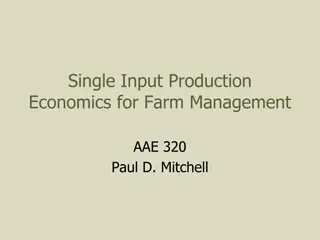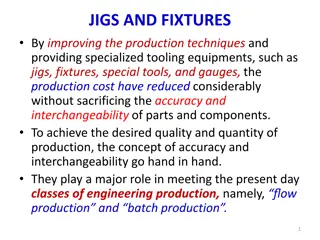Production Economics Examples in Agriculture
This content presents examples of multiple input production economics in agriculture, focusing on optimizing feed ratios for steers and maximizing profit in corn yield by determining the optimal amounts of nitrogen and water to use per acre. The examples include calculations and solutions for achieving economic efficiency in agricultural production.
Download Presentation

Please find below an Image/Link to download the presentation.
The content on the website is provided AS IS for your information and personal use only. It may not be sold, licensed, or shared on other websites without obtaining consent from the author.If you encounter any issues during the download, it is possible that the publisher has removed the file from their server.
You are allowed to download the files provided on this website for personal or commercial use, subject to the condition that they are used lawfully. All files are the property of their respective owners.
The content on the website is provided AS IS for your information and personal use only. It may not be sold, licensed, or shared on other websites without obtaining consent from the author.
E N D
Presentation Transcript
Multiple Input Production Economics EXAMPLES AAE 320 Paul Mitchell pdmitchell@wisc.edu 608-320-1162
Example 1 Grain (lbs) Hay (lbs) MRTS price ratio The table is rations of grain and hay that put 300 lbs of gain on 900 lb steers. 1) Fill in the missing MRTS 2) If grain is $0.06/lb and hay is $0.03/lb, what is the economically optimal feed ration? 825 1350 900 1130 2.93 975 935 1050 770 2.20 1125 625 1.93 1200 525 1275 445 1.07
Example 1: Answer Price Ratio: $0.06/$0.03 = 2.0 Grain (lbs) Hay (lbs) MRTS price ratio = (935 1130)/(975 900) ????? Unknown Grain 1050 770 ????? Known MRTS 2.20 2.00 1.93 825 1350 2.0 Hay 900 1130 2.93 2.0 975 935 2.60 2.0 1125 625 1050 770 2.20 2.0 1125 625 1.93 2.0 Grain ?????= 1050 + (2.0 2.2)1125 1050 1.93 2.2 = 1200 525 1.33 2.0 Hay ?????= 770 + (2.0 2.2)625 770 1.93 2.2 = 1275 445 1.07 2.0 = (525 625)/(1200 1125)
Example 1: Answer Price Ratio: $0.06/$0.03 = 2.0 Grain (lbs) Hay (lbs) MRTS price ratio = (935 1130)/(975 900) ????? Unknown Grain 1050 770 1106 663 1125 625 ????? Known MRTS 2.20 2.00 1.93 825 1350 2.0 Hay 900 1130 2.93 2.0 975 935 2.60 2.0 1050 770 2.20 2.0 1125 625 1.93 2.0 Grain ?????= 1050 + (2.0 2.2)1125 1050 1.93 2.2 = 1106 1200 525 1.33 2.0 Hay ?????= 770 + (2.0 2.2)625 770 1.93 2.2 = 663 1275 445 1.07 2.0 = (525 625)/(1200 1125)
Example 2 Corn yield is Y = 10 + 12N 0.2N2 + 15W 0.3W2 0.1NW, Y = corn yield (bu/ac), N = nitrogen (lbs/ac), W = water (acre inches) Corn price = $3/bu, N price = $0.5/lb, W price = $12/acre inch What is the profit maximizing amount of nitrogen (N) and water (W) to use per acre to grow corn (Y)? Set Up: FOCs: SOCs: Yield & Profit at optimal N and W:
Example 2 Answer Set Up: = 3(10 + 12N 0.2N2 + 15W 0.3W2 0.1NW) 0.5N 12W FOC_N: 3(12 0.4N 0.1W) 0.5 = 0 FOC_W: 3(15 0.6W 0.1N) 12 = 0
Example 2 Answer Set Up: = 3(10 + 12N 0.2N2 + 15W 0.3W2 0.1NW) 0.5N 12W FOC_N: 3(12 0.4N 0.1W) 0.5 = 0 FOC_W: 3(15 0.6W 0.1N) 12 = 0 Solve FOC_N for N: 12 0.4N 0.1W = 0.5/3 = 0.167 12 0.167 0.1W = 0.4N N = 29.58 0.25W Substitute into FOC_W: 15 0.6N 0.1N = 12/3 = 4 15 4 0.6W 0.1(29.58 0.25W) = 0 11 0.6W 2.958 + 0.025W = 0 8.042 = 0.575W W = 13.99 = 14.0 N = 29.58 0.25W = 29.58 0.25(14.0) = 26.1 = N
Example 2 Answer Set Up: = 3(10 + 12N 0.2N2 + 15W 0.3W2 0.1NW) 0.5N 12W FOC_N: 3(12 0.4N 0.1W) 0.5 = 0 FOC_W: 3(15 0.6W 0.1N) 12 = 0 Solve FOC_N for N: 12 0.4N 0.1W = 0.5/3 = 0.167 12 0.167 0.1W = 0.4N N = 29.58 0.25W Substitute into FOC_W: 15 0.6N 0.1N = 12/3 = 4 15 4 0.6W 0.1(29.58 0.25W) = 0 11 0.6W 2.958 + 0.025W = 0 8.042 = 0.575W W = 13.99 = 14.0 N = 29.58 0.25W = 29.58 0.25(14.0) = 26.1 = N
Example 2 Answer Continued SOCs: NN = 3( 0.4) = 1.2 < 0 passes WW = 3( 0.6) = 1.8 < 0 passes NW = 3( 0.1) = 0.03 Then ( 1.2)( 1.8) ( 0.03)2 = 2.16 0.09 = 2.07 > 0 passes Yield = 10 + 12(26.1) 0.2(26.1)2 + 15(14) 0.3(14)2 0.1(26.1)(14) Yield = 301.6 bu/ac Profit = 3(301.6) 0.5(26.1) 12(14) = $723.75/ac (minus other costs)
Example 2 Answer Continued SOCs: NN = 3( 0.4) = 1.2 < 0 passes WW = 3( 0.6) = 1.8 < 0 passes NW = 3( 0.1) = 0.03 Then ( 1.2)( 1.8) ( 0.03)2 = 2.16 0.09 = 2.07 > 0 passes Yield = 10 + 12(26.1) 0.2(26.1)2 + 15(14) 0.3(14)2 0.1(26.1)(14) Yield = 301.6 bu/ac Profit = 3(301.6) 0.5(26.1) 12(14) = $723.75/ac (minus other costs)























